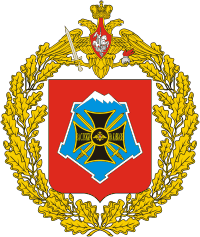The Southern Front was a Front – a roughly Army group sized formation – of the Soviet Army during the Second World War. The Southern Front directed military operations during the Soviet occupation of Bessarabia and Northern Bukovina in 1940, and then was formed twice after the June 1941 German invasion, Operation Barbarossa.
The 4th Army was a Soviet field army of World War II that served on the Eastern front of World War II and in the Caucasus during the Cold War. It was disbanded after the fall of the Soviet Union, with its divisions being withdrawn to Russia and disbanded.
The Separate Coastal Army was an army-level unit in the Red Army that fought in World War II. It was ordered to be established on July 18, 1941 by the order of the Southern Front from the forces of 9th Army’s Coastal Group and was stood up on July 20, 1941.
The 8th Rifle Division was a military formation of the Soviet Union's Red Army in the Winter War, the Soviet invasion of Poland, and World War II. It was formed three times.
The 1st Cavalry Division was formed in October 1939. It fought in the Netherlands, Belgium, France and on the Eastern Front. It was officially transformed into the 24th Panzer Division in late 1941.
The 75th Cavalry Division was a cavalry formation of the Red Army which fought during World War II.
The 41st Cavalry Division (zariovski) was a cavalry formation of the Red Army during the Great Patriotic War.
The 57th Cavalry Division was a cavalry formation of the Red Army during the World War II.
The 7th Guards Cavalry Corps of the Soviet Union's Red Army was a cavalry corps active during the Second World War. It was formed from the 8th Cavalry Corps in February 1943.
The 43rd Cavalry Division was one of the first cavalry divisions formed after the start of the war. The unit was formed in the North Caucasus Military District using the cadre and troops of the district's cavalry training grounds.
The 52nd Cavalry Division was one of the first cavalry divisions formed after the start of the war. The unit was formed at Novocherkassk in the North Caucasus Military District likely from the reservists and cavalry depots in the district's cavalry training grounds.
The 82nd Cavalry Division was formed from August to 18 October 1941 in the Sverdlovsk Oblast in the Urals Military District.
The 31st Army was a field army of the Red Army during the Second World War.
The 32nd Army was a formation of the Soviet Army during World War II. The army was formed twice during the war, disbanded as part of the post-war demobilization and then reformed in 1969 to protect the Soviet-Chinese border.
The 42nd Rifle Division was a unit of the Red Army during the Great Patriotic War. The division, first formed in 1940, was nearly destroyed in the opening days of the Operation Barbarossa defending the Brest Fortress. Disbanded in late December 1941 and immediately reformed in the Volga Military District. The division then served on the front until disbanded at the end of the war.
The 295th Rifle Division was an infantry division of the Soviet Union's Red Army and later the Soviet Army, formed twice.
The 4th Cavalry Corps was a cavalry corps of the Soviet Red Army, formed three times.

The 61st Cavalry Division was a cavalry division of the Red Army that served in the first years of the Great Patriotic War. It was formed in September – October, 1941, and saw its first actions to the south of Stalingrad during the German siege of that city in the autumn of 1942. When the Soviet counteroffensive, Operation Uranus, began in November the 61st formed a significant part of the mobile forces of its 51st Army. After the positions of Romanian 4th Army were broken through the division took part in the exploitation to the southwest, but became overextended and vulnerable to the mobile German reinforcements arriving to attempt a breakthrough to their Sixth Army. The 61st suffered such severe losses that it had to be withdrawn to the reserves in December, and was later disbanded.


